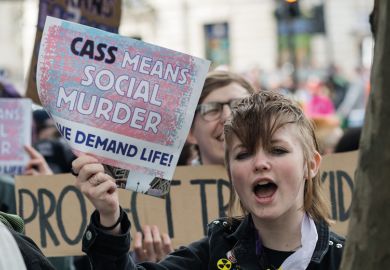Many universities are struggling to make progress on the representation of women among students, staff and invited speakers, a US study suggests.
Research published in Cell Stem Cell, based on data for 541 research institutions, found that about 40 per cent of students, staff and speakers across science, technology, engineering and mathematics were female, on average.
However, while 42 of the 71 institutions (59 per cent) for which data spanning two or more years improved their female representation over this period, 29 (41 per cent) went backwards. The magnitude of the average positive and negative change was similar – 7-8 per cent.
“Our longitudinal analysis revealed no appreciable trend in gender representation changes, albeit over a short period of time and in a relatively limited subset of institutions,” write the authors, from the University of Michigan and the New York Stem Cell Foundation Research Institute (NYSCF).
They collected their data by asking researchers applying to funding from NYSCF between 2016 and 2019 to complete a report card with data on gender representation at their institution and on policies to support women in science. A significant majority (72 per cent) of institutions covered were from North America, with 18 per cent from Europe and several others from Australia; most (86 per cent) were universities.
Women represented more than half of all students, staff and invited speakers at only 103 of the 541 institutions covered (19 per cent). On average, female representation was higher at European institutions (45 per cent) versus North American ones (37 per cent).
Reflecting existing datasets, gender parity decreased as the seniority of the position considered increased. Across all institutions, women made up 57 per cent of undergraduates and 52 per cent of postgraduates.
However, they represented 42 per cent of assistant professors, 34 per cent of associate professors, and only 24 per cent of full professors.
Women were also underrepresented among external speakers (35 per cent) and in committees for staff promotion (33 per cent).
Whitney Beeler, a radiation oncologist at Michigan and a co-author of the paper, said that she had been “disappointed we didn’t find more change over time”. She cautioned that other factors may have affected the figures, especially because the sample was smaller.
“But if there had been real change and big change, we would have picked up on it and there really wasn’t over a four-year period,” she said.
The paper also shows that, at the time of report card submission, only 8 per cent of institutions required a minimum number or percentage of women on committees, just 16 per cent had general policies promoting gender diversity, and 77 per cent had no policy at all.
The findings show that “it will take an enormous amount of leadership and creativity, and persistence – not just from women but men too – to enact real change in female representation”, Dr Beeler said.
“But we know the more diversity you have in a team, the better the intelligence and the more likely you will be successful, so this is good for science, it’s good for everybody,” she said.
Register to continue
Why register?
- Registration is free and only takes a moment
- Once registered, you can read 3 articles a month
- Sign up for our newsletter
Subscribe
Or subscribe for unlimited access to:
- Unlimited access to news, views, insights & reviews
- Digital editions
- Digital access to THE’s university and college rankings analysis
Already registered or a current subscriber? Login








